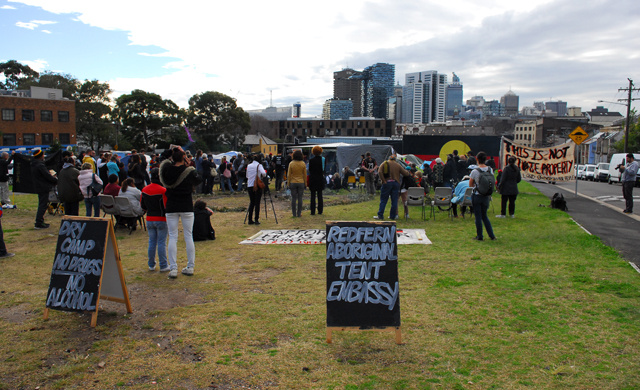As you approach the Aboriginal tent embassy on the Block in Redfern, inner city Sydney, you see the sacred fire burning within a large circle marked on the ground, serving to cleanse the area. Some ten metres up from the fire, at the edge of the Block, the Aboriginal Housing Company (AHC) has erected a sign that reads: “Warning. Private Property.”
Videos by VICE
On Saturday, a group of more than 200 protesters gathered in support of the tent embassy that was established on National Sorry Day, May 26.
The Block, the sacred heartland of Australia’s First Peoples in Sydney, was once an area of low-income housing for Aboriginal residents. It’s now become one of the most expensive and sought after vacant pieces of land in the city.

The sacred fire.
The tent embassy is protesting the development of the $7 million Pemulwuy project, which the AHC is set to build upon the site. The project plans provide for a commercial precinct, accommodation for international students, along with 62 affordable houses for Aboriginal people.
The bone of contention is that while the commercial and student housing component has financial backing, the affordable housing does not, with no funding being provided by either the federal or state governments.
The protesters fear that the affordable housing will never be built.
Three weeks in, the tent embassy is declaring they will be at the site, “the black heart of Sydney”, for the July 7 commencement date of the project and will remain there for the next three years if necessary, until the development application lapses.
Jenny Munro, tent embassy organiser and a founding member of the AHC, told the assembled crowd on Saturday: “The only soil that is turned on this block will be the black housing. I can tell you here and now, we will stand in front of whatever we have to stand in front of: be it police, be it bulldozers, be it the commercial hierarchy in this country and the legal hierarchy. We will defy any and everybody that comes to tell us. We do not have a right to be here.”
“This place is another example of our dispossession. This time it is our own people doing the dispossessing and it’s a really tragic day for our people.”

Jenny Munro speaking to the crowd.
The AHC was formed in 1973, out of a committee that won a grant from the Whitlam government to provide low-income housing for local Aboriginal residents. A series of disputes broke out between a group of local Aboriginal people and police, after fifteen men were arrested for occupying vacant houses in the area. The committee was set up and given permission to occupy two of the vacant houses, which after successful beginnings grew to 41.
Moving into the 1990s, the Block became synonymous with drugs and crime and the terrace houses were not maintained. In 2004, the AHC began tearing down the houses and the last remaining tenant was evicted in 2011.
Today, there is no Aboriginal housing on the Block and the surrounding suburb of Redfern is currently undergoing a decade old process of gentrification.
According to Munro the Block became a place of disrepute after the current chief executive of AHC, Mick Mundine, took over in the 1980s. “All of that dysfunction happened under Micky Mundine. He was responsible for the period of gross mismanagement. He was in charge of it. That happened under his watch: the dysfunction, the drugs, everything,” Munro told VICE.
Mundine has been involved with the AHC since 1975 and has held the position of chief executive for over 30 years. He dismisses claims that the affordable housing component of the project is not a priority.
“Our main focus is affordable housing. Don’t put the students before affordable housing. On the Block land itself we are building 62 affordable houses. That’s approved in the DA,” Mundine said. “Building for the commercial part will start this year and we’ll work very hard with the government to start the affordable housing next year.”
Kaye Bellear and her late husband Bob, the first Aboriginal judge in Australia, were integral in the formation of the AHC. Bellear, who addressed the rally on Saturday, calls for the AHC to return to its original mandate and points to the Block’s links to the inception of the Indigenous land rights movement in Australia.

“It was the first land owned freehold by any Aboriginal community in the country,” Bellear said. “The membership should be opened up to the company, a new board should be voted in and then people need to sit down and work out how they can house Aboriginal people on that block.”
The project is named after Pemulwuy, a member of the Eora tribe of Sydney, who fought the British for twelve years after they arrived in the country. He’s a figure of resistance for Indigenous Australians. Munro, a Wiradjuri elder, is outraged by the name. “You know calling this project Pemulwuy, is an insult to the man that defended our country, all of our country.”
The burgeoning tent embassy has grown from a single tent on the first day to around twenty at the time of the rally. It encompasses much of the area of the Block. Equipped with a kitchen, running on donations and with daily visits, it certainly looks pitched to stay.
Follow Paul on Twitter: @paulgregoire
